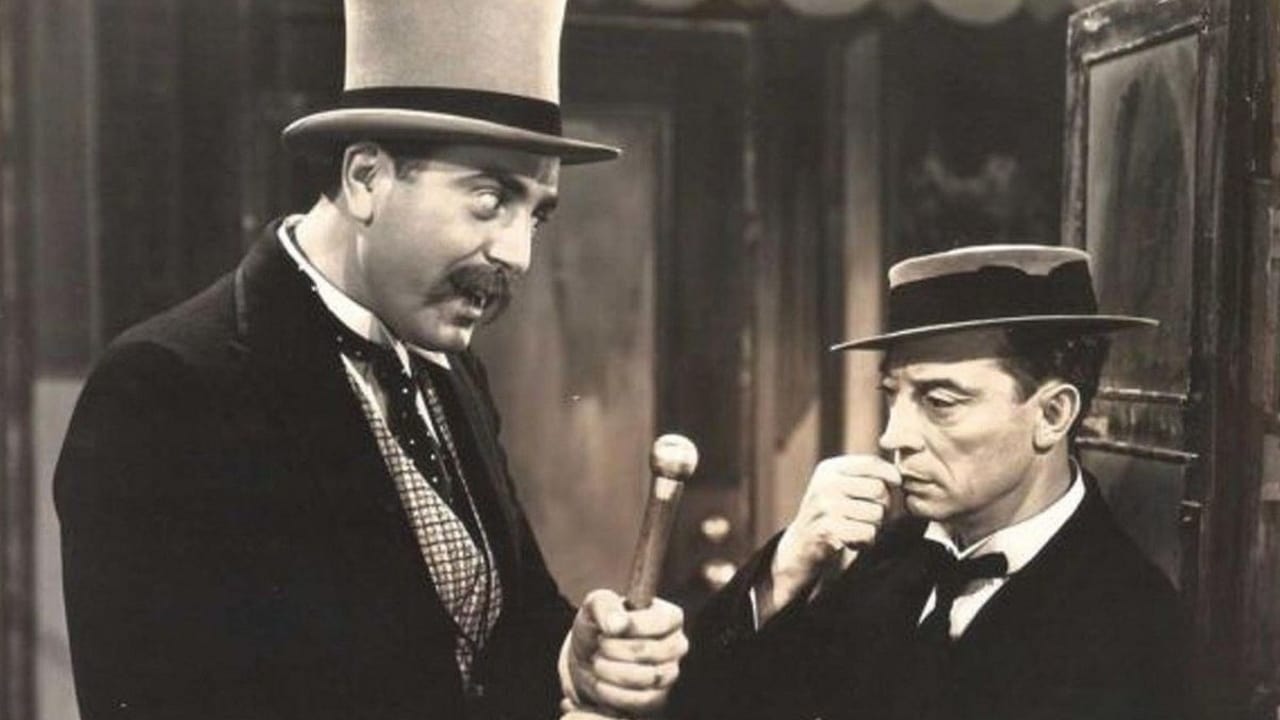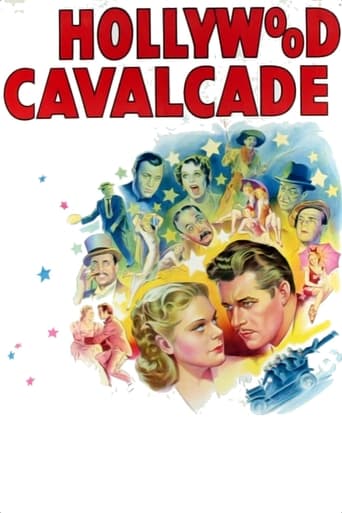

The first half of this film is a fast-paced comedy that seems to have promise. The story has Don Ameche as director Mike Conners, who spots Molly Hayden (Alice Faye) one day and thinks this great beauty could be a big star. He signs her to a contract and she is set to make her debut in a dramatic film. However, Buster Keaton is on the set, cast as Molly's romantic interest in the film. He hurls a custard pie at her and a food fight ensues. Mike has discovered a new form of cinema - slapstick comedy. Molly is his big star, but he is ignoring her personally. At the point where he decides to make Molly a big dramatic actress instead of a comedian, the film also goes from comedy to melodrama. It's not that the movie is bad drama, it's just after the humorous first half I was hoping for more of a humorous second half.This film is also notable for Buster Keaton's first appearance in an American-made feature film after he was fired from MGM in 1933. The intensity of Buster's pie attack on Alice Faye was quite a surprise to her. After the scene was shot apparently she grabbed her own pie and chased Keaton quite a distance before he could finally outrun her.
... View MoreThe plot: Michael Linnett Connors has done everything in films but direct, and is looking for his 1st big chance. He discovers Molly in a play and at once knows she will be a big film star. He signs her to a contract with the stipulation that he must direct. The producer agrees and their big time careers are under way. What follows is a recreation of the silent film era and early sound movies with great emphasis on comedy. And, oh yes, there's romance, and a little sadness too. The performances by Don Ameche and Alice Fay are top notch. The music is a real plus too with some old familiar tunes heard. Lots of DVD extras as well in this restored version released in 2008. It must be emphasized that this movie is a story 1st, not just a tribute to silent films. Later years would bring similar films such as, Singin' in the Rain(1952) & Dick Van Dyke-Carl Reiner's, The Comic(1969). What is special about this film, though, is recreating silent movies in 1939. We see portions of them as the cinema audience would in that bygone era(although some sound effects are included)in glorious b&w, while the rest of the movie is in pristine color. One of the greatest in the silent era, Buster Keaton, who at this point was on an uphill climb, is used superbly in 2 silent film recreated scenes and he is on the top of his game! It is said that he had some input on his scenes as well. But the real reason to watch the movie, if your a motion picture history fan, is that beyond everything else, Hollywood Cavalcade is Mack Sennett's film legacy. It doesn't take a genius to realize this movie is a "positive" reworking of Mack Sennett's and Mabel Normand's life. The character Michael "Linnett" Connors is Mack Sennett, whose real name was Michael Sinnott. And Molly, of course is Mabel. Sennett had the pie throwings, the bathing beauties and Keystone Cops. He worked with Buster Keaton, Ben Turpin(cameo), Roscoe "Fatty" Arbuckle(body double) and fell in love with his leading lady. Not only all that, but Sennett was technical adviser for this film and appears in it as well. As most film viewers today prefer sound features, those who were associated with short subjects and silents are left out to pasture. As Mack Sennett fell into that category, it is fortunate that there is Hollywood Cavalcade! Sennett was of course very instrumental in the evolution of comedy in movies. His career started in 1908 as an actor, then writer, director & producer. He semi retired in 1935 with about 500 films to his credit. He had worked with the best, such as Charlie Chaplin, Gloria Swanson, Bing Crosby, W.C. Fields, Keaton, Harry Langdon, Arbuckle, and even Roy Rogers(in Way Up Thar).As film comedy is an extremely difficult path to continue for an entire career, Mack played it wise & did only selective work for the next 25 years. In 1931 he had received an academy award in the short subject category, and another in 1937 for a lifetime of work. In the 1940's his presence was still felt, e.g. Here Come the Co-Eds(1945)where a recreation of the oyster soup scene used in Mack's Wandering Willies(1926)is done. In 1947, The Road to Hollywood, used some of Sennett's Crosby films. 2 years later brought some nostalgia with the film Down Memory Lane in which he participated. With his knack of always associating with the right people, a guest role with the eternally popular Lawrence Welk & his radio show came about later in the year. 1950 brought a re-release of his greatest triumph, Tillie's Punctured Romance(1914) with sound. In 1952 he was honored on TV's, This Is Your Life, then his autobiography, The King of Comedy(1954), which is a great companion piece to Hollywood Cavalcade, was published. 1955 brought a more concrete association with Abbott & Costello, as he had a cameo in A&C Meet the Keystone Kops. Finally in 1957, another tribute with the compilation film, The Golden Age of Comedy. So when you watch Hollywood Cavalcade it is the legacy of a motion picture pioneer. In the film at the banquet scene the camera pans over the guests at a long table. As we get to the silver haired Mack, he alone turns his head to the camera as if to say, "here I am!". When he rises to give a speech a short while later, he is at his most subdued, underplaying the words given him as if to mentally convey, "I know my influence on comedy will never end, but will people forget Mack Sennett the individual. Maybe this movie will help."
... View MoreAs most moviegoers know, 1939 was a year of some very great movies, but "Hollywood Cavalcade" was not one of them. It probably was a big hit at the time, as it adventurously combined Technicolor and Black & White photography, but it has not stood the passing of time nearly as well as many of those made in the same year. One expects with the casting Of Alice Faye and Don Ameche it would be a musical - this is not the case although there were many opportunities for some songs of the era. The story is a pretty hackneyed one of girl meets boy, girl loses boy and finally girl gets boy, so there is no need to dwell on that. The inclusion of some of the stars of the silent era (including the Keystone Kops) is the most interesting feature, but the sequence with Al Jolson was a bit much!!! J. Edward Bromberg made a very interesting character adding some zing to the story. If you see it on Video or DVD, it is interesting enough to pass a 100 minutes or so.
... View MoreIn the earliest years of silent cinema, former prop boy Mike (Don Ameche) "discovers" a charming Broadway understudy, Molly (Alice Faye), and impulsively hires her to a personal contract to star in pictures. With Mike as director, Molly is set to appear in a film with Buster Keaton as her boyfriend -- but things get out of hand, the first day on the set.By accident, Buster flings a custard pie into Molly's lovely face, thus throwing off the rhythm of their primly choreographed love scene. Soon Molly, Buster, and the "villain" of their scene (George Givot) are covered in custard, and the laughing and applauding onlookers convince Mike he's discovered a new screen genre. He milks it for all it's worth, launching a series of slapstick comedies -- with pies, bathing beauties, and Keystone-style Kops -- all featuring Molly, who becomes a big star.If "Hollywood Cavalcade" had continued in this same vein, it would probably have become a classic. Instead, about halfway through, Mike makes the decision to turn Molly into a dramatic actress, starring in serious photoplays and leaving her slapstick days behind.The film's second half turns maudlin when Molly, whose love for Mike seems unrequited, marries her new costar Nicky (Alan Curtis). Having lost his biggest star, Mike slides into despair, his films regularly losing money. Then Nicky is killed in a traffic accident and Molly teams up with Mike again. They make a hit picture, and discover that they've loved each other all along."Hollywood Cavalcade" marked two firsts for Alice Faye: her first Technicolor film, and also the first in which she sings not a single note. But her performance was generally lauded by the film critics.
... View More